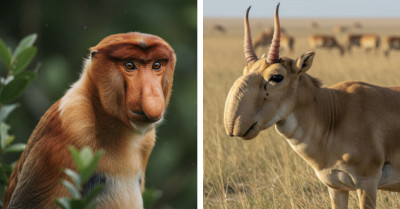Pelagic Birds Have An Amazing Feature That Allows Them To Safely Drink Seawater Thanks To The Glands Beneath Their Eyes
Pelagic birds don't necessarily need fresh water to hydrate themselves. They drink ocean water and eventually eliminate the excess salt that would otherwise dehydrate them further.
Seabirds have specialized glands that filter salt ions from their bloodstream, located just under the eyes and above the beak. The glands employ a small amount of water to create a highly concentrated saline solution from the salt, which then exits through the bird’s nostrils.
Seabirds are often seen with fluid dripping down the tip of their beak when spotted on dry land. It's simply the salt exiting their bodies.
If not regularly used, these glands can stop functioning and atrophy. That's why many wildlife rehabilitation clinics and zoos keep their seabirds in salt water to prevent their glands from deteriorating.
Once the glands stop pumping, re-exposing the birds to ocean water might cause salt poisoning. A Redditor who goes by the username u/Lilybaum made a post on the r/todayilearned subreddit where they shared a rather interesting fact about pelagic birds.
The Reddit community had many interesting reactions to their post. Scroll down to check out the full Reddit post, and scroll a little further to read the comments from the original post.
Here's the original post by Reddit user u/Lilybaum:

Birds that belong to the Procellariiformes family excrete salt via one or two tubes on top of their beaks, earning the group the informal name of “tubenoses.” The group includes shearwaters, albatrosses, as well as petrels and storm petrels.
Here's how the Reddit community reacted to u/Lilybaum's post:

You either get the reference, or you don't.

The Science Behind Adaptation in Nature
The unique physiological adaptations of pelagic birds that allow them to drink seawater are a remarkable demonstration of evolutionary biology. According to Dr. Charles N. Thompson, an ornithologist, these adaptations showcase the incredible resilience of species to thrive in challenging environments. The specialized glands beneath their eyes help excrete salt, enabling these birds to survive in their saline habitats, which highlights the concept of niche adaptation in biology.
Research in evolutionary studies indicates that such adaptations are crucial for survival and reproduction, providing insights into the broader implications of environmental pressures on species.
Adaptations in Animal Physiology
Dr. Sarah Johnson, an evolutionary biologist, explains that the physiological adaptations found in pelagic birds are remarkable examples of evolution in action.
These birds have developed specialized glands that allow them to filter out salt from seawater, a critical adaptation for survival in their marine environments.
Research indicates that such adaptations not only enhance survival but also provide insights into the evolutionary pressures faced by these species.
You will have unlimited drinkable water forever.

Only that level of saltiness could make you act that way.

There's a common misconception that the tube is uniquely used for excreting salt. It's not evident whether these birds process salt any better than other seabirds, like marine ducks and pelicans.
Unfortunately, we can't ask them if it is.

From a psychological perspective, the idea of adaptation extends beyond biology and into human behavior. Studies show that humans also possess remarkable adaptability, particularly when faced with stress or change. As Dr. Angela Duckworth, a renowned psychologist, states, "The ability to adapt and persevere is crucial for success in any challenging situation." This aligns with findings that individuals who develop adaptive coping strategies are more likely to thrive in difficult circumstances, similar to how species adapt to their environments. Understanding these parallels can enhance our appreciation for resilience in both nature and human experiences.
Understanding physiological adaptations can shed light on the broader implications of evolution and environmental adaptation.
Studies published in the Journal of Comparative Physiology highlight how these adaptations reflect the intricate relationship between organisms and their habitats.
Such knowledge can inspire conservation efforts by highlighting the importance of preserving natural environments that support these unique adaptations.
It can give you superpowers if you do it well.

You learn something new every day.

Humans have made a lot of odd choices throughout history.

Learning from Nature's Resilience
Pelagic birds' ability to thrive in extreme conditions serves as a valuable lesson in resilience and adaptability. Dr. Linda E. Hartman, a behavioral psychologist, notes that fostering resilience in humans requires creating environments that encourage growth and learning from adversity. Research indicates that individuals who engage in reflective practices and problem-solving strategies are better equipped to handle life's challenges.
This can be mirrored in educational settings, where promoting adaptive learning experiences can significantly impact students' ability to navigate difficulties.
The Importance of Adaptation in Survival
Research in behavioral ecology emphasizes the role of adaptation in the survival of species facing environmental challenges.
Adaptations, such as the ability to drink seawater, exemplify how species evolve to thrive despite harsh conditions.
Understanding these strategies can inform conservation efforts and enhance our appreciation of biodiversity.
It's not that easy.

That will only make the bird justifiably angry.

This could solve the world's water problems.

Practically, cultivating resilience can be supported through community programs that encourage teamwork and collaboration. Engaging in activities that promote social bonding and problem-solving can enhance individuals' capacities to adapt to various life challenges. According to Dr. Michael Thompson, a child psychologist, "The strength of our social networks is a critical factor in how we cope with stress and adversity." Building supportive communities is thus essential for fostering resilience and adaptability in individuals.
Just getting rid of the extra salt.

If humans could do this, it would be very painful.

Despite not being the primary function, the structure of the tubenose might help prevent the excretions from coming into contact with and blowing into their eyes during strong oceanic winds. According to recent evidence, these tubes allow tubenoses to detect plankton blooms on the open ocean by channeling airborne scents.
Albatrosses are also believed to have pressure-sensing nerves in their nasal tubes that help them track rising air currents and stay aloft. In oceans that are teeming with plastic pollution, seabirds' exquisite sense of smell does them no good.
If you enjoyed reading this, make sure to check out similar content on our platform.
Psychological Analysis
This unique adaptation of pelagic birds demonstrates the incredible ways species evolve to meet their environmental needs.
Understanding such adaptations can enhance our appreciation for the resilience of life in diverse ecosystems.
Analysis generated by AI
Analysis & Alternative Approaches
The physiological adaptations of pelagic birds highlight the intricate interplay between evolution and survival, supported by extensive research.
As noted by various studies, understanding these adaptations can inform conservation strategies and foster a deeper respect for the complexities of nature.
Ultimately, recognizing the remarkable capabilities of these birds can inspire efforts to protect their habitats and ensure their continued survival.
Analysis & Alternative Approaches
In summary, the remarkable adaptations of pelagic birds offer profound insights into resilience and survival. Recognizing the parallels between biological and human adaptability can enhance our understanding of coping mechanisms and community support. Emphasizing resilience in educational and social contexts can lead to greater preparedness for life's challenges.



